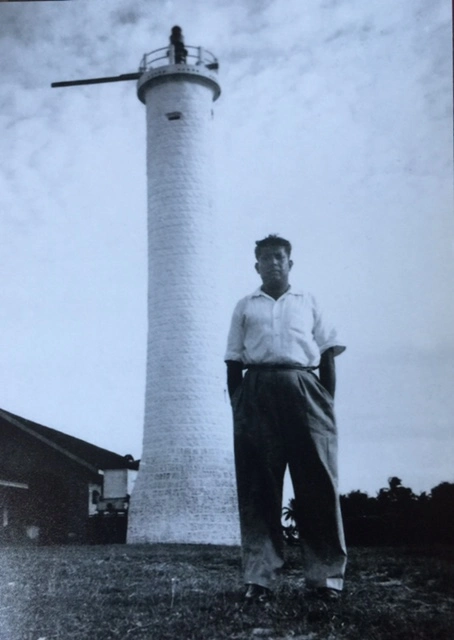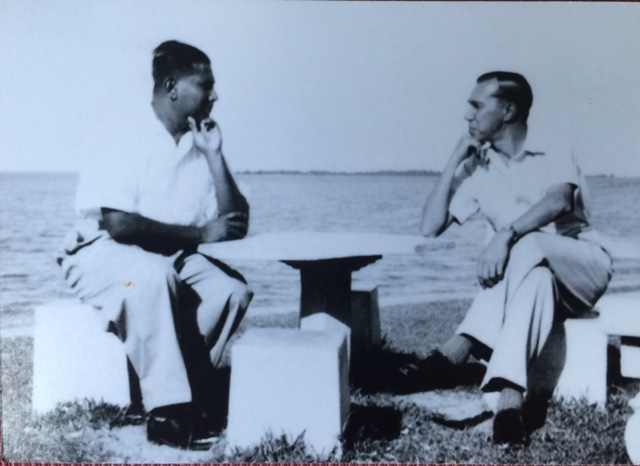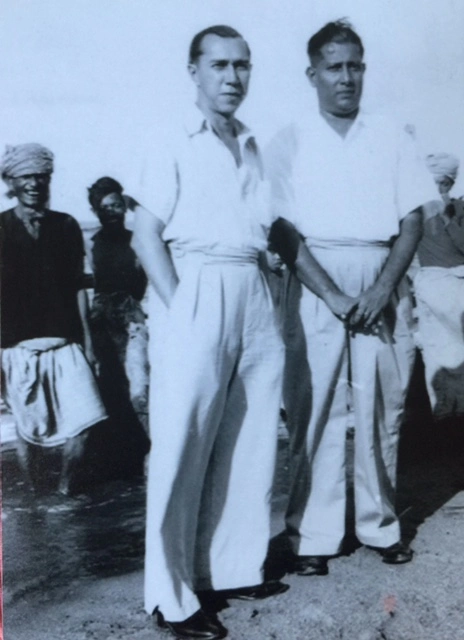
On August 31 1956 Malayan Railwayman David Colundasamy Aloysius John had a heart attack and died. He was 47. He missed Merdeka Day by exactly a year, so never got to see the country of his birth gain independence from Britain. He also missed my third birthday by 24 days. So I grew up knowing little of the man who was my father. I can’t describe the sound of his voice or the look on his face when he was happy, sad or furious. I don’t know if he sang in the bathroom like I do. What I do have are some small black-and-white photographs of my father that I have looked at again and again as a child, growing up and as an adult and brought with me to Singapore after I moved from Kuala Lumpur in 1980.
One picture, in particular, fascinated me for the longest time. It shows my father standing in front of a brick lighthouse, unsmiling, his hair blown by the breeze, his hands in the pockets of his baggy cotton trousers. He posed for that picture in Tumpat, a coastal town in the northeastern Malaysian state of Kelantan. Tumpat was the final stop of the Malayan Railway’s eastern line that used to run all the way from Tanjong Pagar in Singapore to this far corner of the Malay peninsula, near the border with Thailand. I have been drawn to this picture countless times. My father did not know that day in 1952 that he would have a son the following year, or that his life was so near its end.
It has taken me 60 years to go in search of my father’s lighthouse. I’d thought of doing this many times, but it was only after I’d put my life in newspapers behind me that I finally made the trip to look for it, as if this was something to do before it got too late. The Internet told me the lighthouse was still standing, but I didn’t know what I hoped to find. My old friend Chin Kin Yong drove with me by car to Kelantan in March of this year and one morning we made it to Tumpat, twenty minutes outside the state capital Kota Baru.
We had reached Kelantan by driving diagonally across the peninsula from Kuala Lumpur, through the country’s main mountain range, and it took us about eight hours with stops along the way. The train journey would take almost a day and you’d have to first ride south from Kuala Lumpur on the west coast all the way to the railway interchange town of Gemas in Johor, change trains and then go all the way up north on the east coast to the end of the line. At Tumpat, the rail tracks run a short distance beyond the station platform before coming to an abrupt stop. Then there’s just gravel and a fence.
In February 1952 my father was in Tumpat with his Malayan Railways colleague and friend, Henry Lang Taylor, and they would have taken the long train ride from Kuala Lumpur to get there. I don’t know how much time they spent in Tumpat, but they stayed at the Railway guest house for executive officers when the set of black and white photographs were taken. It is so clear from the way these two men appear, striking various poses so comfortably indoors and outdoors, that they were the best of friends.



Both were born in 1909 in colonial Malaya. Both were educated at De La Salle schools run by the Christian Brothers – my father at St Francis’ Institution in Malacca, and his friend at St Xavier’s Institution, Penang. Both survived World War Two and the Japanese Occupation. Both worked as Malayan Railways accounts inspectors, visiting stations across Malaya to audit the books.
Both men also married the same woman, my mother Agnes.
When my father died, he left my mother a widow at 26 with four young children – my older sister Barbara and me, and our cousins Denis and Audrey whom my parents had adopted after their father, my mother’s brother Justin, died. Our lives were turned upside-down by my father’s sudden death. My sisters were put in a boarding school run by Catholic nuns and my mother who had never worked outside the home took a job as a telephone operator at Braddell & Ramani, a Kuala Lumpur law firm. There was an upheaval and breaking away from my father’s side of the family and we would never be close. He was the second of five brothers and although three survived him, none figured in our lives in a good way after his death. It was my mother’s youngest brother Charlie, who was a clerk in his early twenties and not yet married, who helped most by letting us move in with him in his government quarters in Jinjang North New Village outside Kuala Lumpur.
Our lives changed again on July 4 1959, when my mother married Henry Lang Taylor, my father’s best friend and the other person in those Tumpat photographs. Uncle Henry, which is what we called him until grandchildren came along and he became Grandpa to everyone, was Eurasian, Catholic and divorced. He had lost a young son in the war, and his ex-wife had taken their other son, Errol, to live in Perth, Western Australia. Uncle Henry almost never talked about his earlier life, and it was many years before Errol came to visit as a young man in the Australian Navy. When my mother married Henry Taylor it set tongues wagging, to say the least, because in 1959 it was simply not the done thing for a young, Indian, Catholic widow to go off and marry a divorced man. My mother never forgave the people who disapproved.
My stepfather was a mild-tempered homebody and everyone who got to know him could see that he was a good man; it surely takes someone special to marry a widow with four children. He brought our family together, upgraded our lives by taking us to a new home in the sprawling Sentul railway settlement with its hierarchy of housing types ranging from terraced lines of the smallest homes to double-storey brick bungalows fronting a golf course. You knew you were in a railway community because the houses were painted a standard cream and brown. You can still spot colonial-era Malayan Railway quarters in towns across the peninsula by their templated designs and colour scheme. Our new home was a raised bungalow with a large compound on Graeme Road, where the Railways’ mid-level executives had their houses. It was my stepfather who decided I should attend St John’s Institution, the premier Christian Brothers school in Kuala Lumpur, and that had the most long-lasting effect on my life. He and my mother had two daughters, and our lives carried on.

Because Malaya gained independence on August 31 1957, my father’s death anniversary was a public holiday and every year we would make the trip to the Cheras cemetery to leave flowers and light candles at his grave. I remember more of the cemetery trips than of my father. There are people who say their earliest memories stretch all the way to infancy, but I’m not one of them. I’ve sometimes wondered if the trauma of his sudden passing wiped out everything I knew of him to the extent that I remember nothing at all. In one family picture taken in a photo studio, I am a toddler on his lap, and he is calm and unsmiling. We have no informal pictures from the 1950s, so I don’t know what he was like when he was relaxed, in his home clothes. I don’t know if he ever tossed me in the air or kissed me.
My mother was not given to talking about my father. They were first cousins, and although it was not uncommon at the time among Malayalee Catholics for first cousins to marry, my parents did not marry for love. She was sixteen and he was twenty years older and one day after the war he decided it was time to marry and chose her. At the same time, her elder sister Beatrice married his youngest brother Michael. Sometimes my mother let on that my father was a dramatic teller of stories who could hold an audience spellbound. Or that he had a terrible temper. She often described sudden widowhood as the time when she realised she did not know how to do anything because my father had taken care of all the important matters, and even went to the market for the family. He was always running late to catch the train that took him from our railway quarters to his office. But he worked hard and was honest, which was why he did not leave much when he died. Random snippets from a ten-year marriage. My stepfather shared even less about his good friend.
As I grew up, older folk who knew him would sometimes remark that I looked just like my father and for some reason that always felt good. And, as if this was all I needed to know about him, they would tsk sadly and add: “The good die young.” I did not long to know more about my father and was never aware of a hole in my heart that needed to be filled, and did not ask questions when I could. But coming across the old photographs, I would always pause, and the older I got, the longer I would linger over the details of my father’s features, his eyes and eyebrows, the shape of his lips and fingers, and the bump on his forehead. Sometimes it frustrated me that all I could see was a pleasant-faced Indian man who rarely smiled for the camera.


The Tumpat pictures are precious for showing my father and stepfather together. They are 43 years old and the day they posed for pictures, they were relaxed and clearly happy despite the absence of smiles. There are pictures inside and outside the rest house, having a cup of tea, lounging in large low arm chairs that were the Railways’ standard-issue furniture. There they are outdoors, standing with arms folded or hands in their pockets, holding boxy briefcases and pretending to be setting off on a mission. There are some shots in a park and at the seaside, with Kelantanese fishermen in the background. My father wears a grin in only one picture, where he and his friend stand facing each other in front of some palm trees. The hand-written caption on the back says: “A chin-wag in the garden of the Railway Rest House – Tumpat.” It is dated February 19 1952.


It is March 18 2016 and nearly 60 years after my father’s death when I arrive in Tumpat. As Kin Yong and I drive along the road to the train station, I feel an odd excitement at spotting the first Malayan Railway houses in their faded cream and brown colour scheme. The station itself is an unexceptional building, but on its platform there are features from an earlier era, including Made-in-England wrought iron roof trims that would have been there when my father visited. We get directions and find my father’s lighthouse, now marooned within the compound of the station’s maintenance workshop. In the decades since my father was here, the coastline has moved and houses have sprouted where the sea used to wash up. A guard stops me from going to the lighthouse because this is a restricted area, but he relents after I show him my father’s photo on my iPhone and Kin Yong assures him we will be quick. I get my own pictures with my father’s lighthouse. A little later, we find the very bungalow where my father and stepfather lounged with cups of tea and posed for pictures. Amazingly, it is still the guest house for visiting Railway executives. And then we leave the place.
Afterwards I am unable to describe that morning in Tumpat when people who knew of my trip ask: “So did you find your father’s lighthouse?” But I return to the photograph again and again. In it, he is alone and stares directly at the camera with no trace of a smile on his face. What if he had known that day that he had only four more years to live? How differently would he have spent the remaining time? What would he have stopped doing, started doing? Who would he have treated better? And after his son arrived, would he have cared that the boy would grow up never knowing him, and might that have prompted him to write a letter to tell me who he was and how he hoped I might remember him? Would he have described how he and his brothers were orphaned young, or explained what broke for them along the way and kept them so separate as adults, seemingly uncaring and indifferent to one another, never close? Would he have told me who he loved truly, and how and why? Would my father the storyteller have told me a story? His story?
My friend Chin Kin Yong took the photo of me with my father’s lighthouse.



Totally enjoyed the article ‘In search of my father’s lighthouse’. Pictures you showed evoked memories of my family when they were in Port Swettenham and later Klang. My granfather worked in the railways. My dad was sent to Malaysia from Sri Lanka to study here as my grandparents were siblings. Dad and mum were first cousins too! My dad died at the age of 65 when I was about 24. So I did get to enjoy good moments with him but he too was a quiet man and had many unsmiling moments! Just could relate to the events and all the recollections so well.
Your article just struck a chord…like reading a ‘Chicken Soup for the Soul’ moment. Thank you!
LikeLike
As someone who is privileged to call Alan my friend, I love reading about his background stories, the foundation that he is built from. Having moved away from him, so many years ago, it’s so refreshing to ‘share’ his present moments, in his website and in his book “Good Grief!”. He’s still very much the ‘Alan John’ who gamboled with me and our group of fresh young reporters when we started our working lives together. Now in his retirement, I’m delighted to see that Alan is still the thoughtful, vulnerable and fun loving man he was almost 40 years ago.
LikeLike
Thank you Phylis. There was a time when so many good friends left for faraway places and it was sad to be left behind. But the years proved that true friends stay connected despite the distance and the periods when work and life get in the way. Thank you for being here still.
LikeLike
Hi Alan,
I accidentally came across your website when I read the St John’s Institution page on Facebook. And enjoyed reading your story “My father’s lighthouse “.
You might remember me living in United Garden, and going to SJI from whom I got a ride in the morning. You were the School Captain in 1972, and I was one year your junior in Lower 6. Thank you for your kindness. I am still in contact with the School Captain in my year, Jeffery Tan.
I left SJI in January 1973 to pursue an Aircraft Maintenance Engineering course in Australia, and returned to KL in 1978.
Thanks and God bless.
Chang Hoe Yoon
LikeLike
Hi Hoe Yoon, thanks for checking in and writing to me. Gosh I don’t recall our rides to school, but I’ll take your word for it and thank you for remembering. It’s funny and nice that we share a connection after so many decades because we went to SJI. Say hello to Jeffery for me, why do I remember him being in a state of perpetual horror at my lack of seriousness as head boy! I have Tan Vooi Giap to thank for putting that 2016 story of mine on the SJI Facebook page, and quite a few Malaysian readers have turned up over the past couple of days. Now you know where to find me, say hello sometimes. Cheers, Alan
LikeLike